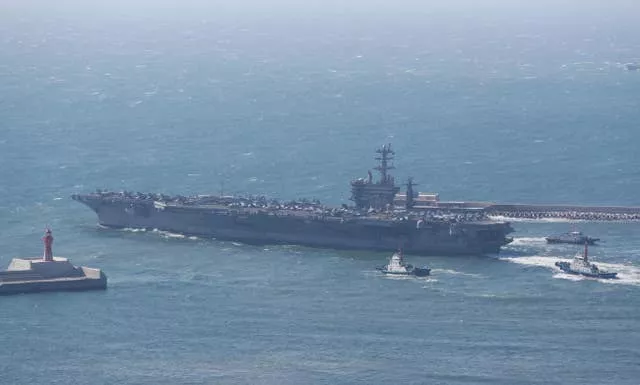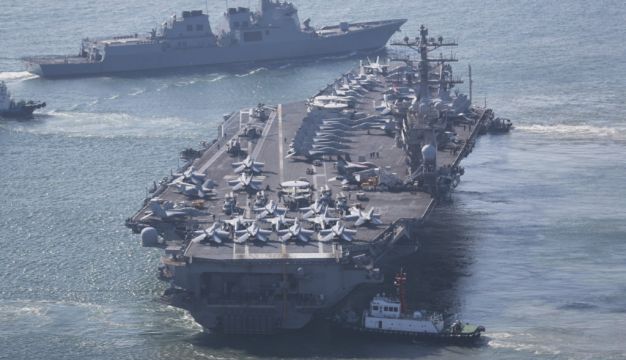The South Korean, US and Japanese navies have begun their first anti-submarine drills in six months to boost their coordination against increasing North Korean missile threats, officials said.
The two-day exercises come as North Korea’s recent unveiling of a type of battlefield nuclear warhead prompted worries the country may conduct its first nuclear test since 2017.
The maritime exercises in international waters off South Korea’s southern island of Jeju involved the nuclear-powered USS Nimitz aircraft carrier and naval destroyers from South Korea, the US and Japan, South Korea’s defence ministry said.
The training was arranged to improve the three countries’ capacities to respond to underwater security threats posed by North Korea’s advancing submarine-launched ballistic missiles and other assets, the statement said.
It added that the three countries were to detect and track unmanned South Korean and US underwater vehicles posing as enemy submarines and other assets.
Submarine-launched missiles by North Korea are serious security threats to the United States and its allies because it is harder to spot such launches in advance.
In recent years, the North has been testing sophisticated underwater-launched ballistic missiles and pushing to build bigger submarines including a nuclear-powered one.
Last month, North Korea performed a barrage of missile tests in response to the earlier South Korea-US bilateral military drills.

The weapons tested included a nuclear-capable underwater drone and a submarine-launched cruise missile, which suggest North Korea is trying to diversify its kinds of underwater weapons.
Photographs in North Korea’s state media last week showed about 10 capsule-shaped, red-tipped warheads called “Hwasan (volcano)-31” with different serial numbers.
A poster on a nearby wall listed eight kinds of short-range weapons that can carry the “Hwasan-31” warhead. The previous test flights of those weapons show they are capable of striking key targets in South Korea, including US military bases there.
Some observers say the warhead’s unveiling may be a prelude to a nuclear test as North Korea’s last two tests in 2016 and 2017 followed the disclosures of other warheads. If it does conduct a nuclear test, it would be its seventh detonation overall and the first since September 2017.
Foreign experts debate whether North Korea has functioning nuclear-armed missiles. But South Korea’s defence minister, Lee Jong-Sup, recently said the North’s technology to build miniaturised warheads to be mounted on advanced short-range missiles was believed to have made considerable progress.
North Korea could carry out new missile tests in response to the South Korea-US-Japan drills because it views such training as a security threat.
North Korean leader Kim Jong Un called recent South Korea-US exercises “reckless military provocations” that disregarded North Korea’s “patience and warning”.
In remarks carried in the defence ministry statement, Rear Adm Kim Inho, chief of the South Korean forces involved in the trilateral drills, said: “We’ll decisively respond to and neutralise any type of provocation by North Korea.”
In addition to anti-submarine drills, the three countries will practice humanitarian search-and-rescue operations, including saving people who fall into the water and treating emergency patients.
It would be the three countries’ first such training in seven years, the defence ministry statement said.







